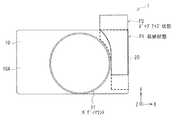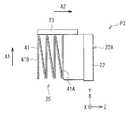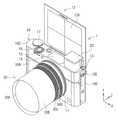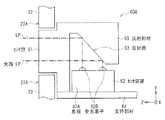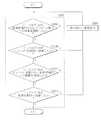JP2015227901A - Image pickup apparatus - Google Patents
Image pickup apparatusDownload PDFInfo
- Publication number
- JP2015227901A JP2015227901AJP2014101708AJP2014101708AJP2015227901AJP 2015227901 AJP2015227901 AJP 2015227901AJP 2014101708 AJP2014101708 AJP 2014101708AJP 2014101708 AJP2014101708 AJP 2014101708AJP 2015227901 AJP2015227901 AJP 2015227901A
- Authority
- JP
- Japan
- Prior art keywords
- state
- viewfinder
- unit
- main body
- control unit
- Prior art date
- Legal status (The legal status is an assumption and is not a legal conclusion. Google has not performed a legal analysis and makes no representation as to the accuracy of the status listed.)
- Pending
Links
Images
Classifications
- G—PHYSICS
- G03—PHOTOGRAPHY; CINEMATOGRAPHY; ANALOGOUS TECHNIQUES USING WAVES OTHER THAN OPTICAL WAVES; ELECTROGRAPHY; HOLOGRAPHY
- G03B—APPARATUS OR ARRANGEMENTS FOR TAKING PHOTOGRAPHS OR FOR PROJECTING OR VIEWING THEM; APPARATUS OR ARRANGEMENTS EMPLOYING ANALOGOUS TECHNIQUES USING WAVES OTHER THAN OPTICAL WAVES; ACCESSORIES THEREFOR
- G03B17/00—Details of cameras or camera bodies; Accessories therefor
- G03B17/02—Bodies
- G03B17/04—Bodies collapsible, foldable or extensible, e.g. book type
- G—PHYSICS
- G03—PHOTOGRAPHY; CINEMATOGRAPHY; ANALOGOUS TECHNIQUES USING WAVES OTHER THAN OPTICAL WAVES; ELECTROGRAPHY; HOLOGRAPHY
- G03B—APPARATUS OR ARRANGEMENTS FOR TAKING PHOTOGRAPHS OR FOR PROJECTING OR VIEWING THEM; APPARATUS OR ARRANGEMENTS EMPLOYING ANALOGOUS TECHNIQUES USING WAVES OTHER THAN OPTICAL WAVES; ACCESSORIES THEREFOR
- G03B13/00—Viewfinders; Focusing aids for cameras; Means for focusing for cameras; Autofocus systems for cameras
- G03B13/02—Viewfinders
- H—ELECTRICITY
- H04—ELECTRIC COMMUNICATION TECHNIQUE
- H04N—PICTORIAL COMMUNICATION, e.g. TELEVISION
- H04N23/00—Cameras or camera modules comprising electronic image sensors; Control thereof
- H04N23/50—Constructional details
- H04N23/51—Housings
- H—ELECTRICITY
- H04—ELECTRIC COMMUNICATION TECHNIQUE
- H04N—PICTORIAL COMMUNICATION, e.g. TELEVISION
- H04N23/00—Cameras or camera modules comprising electronic image sensors; Control thereof
- H04N23/50—Constructional details
- H04N23/53—Constructional details of electronic viewfinders, e.g. rotatable or detachable
- H04N23/531—Constructional details of electronic viewfinders, e.g. rotatable or detachable being rotatable or detachable
- H—ELECTRICITY
- H04—ELECTRIC COMMUNICATION TECHNIQUE
- H04N—PICTORIAL COMMUNICATION, e.g. TELEVISION
- H04N23/00—Cameras or camera modules comprising electronic image sensors; Control thereof
- H04N23/60—Control of cameras or camera modules
- H04N23/667—Camera operation mode switching, e.g. between still and video, sport and normal or high- and low-resolution modes
- G—PHYSICS
- G06—COMPUTING OR CALCULATING; COUNTING
- G06F—ELECTRIC DIGITAL DATA PROCESSING
- G06F2200/00—Indexing scheme relating to G06F1/04 - G06F1/32
- G06F2200/16—Indexing scheme relating to G06F1/16 - G06F1/18
- G06F2200/161—Indexing scheme relating to constructional details of the monitor
- G06F2200/1614—Image rotation following screen orientation, e.g. switching from landscape to portrait mode
- H—ELECTRICITY
- H04—ELECTRIC COMMUNICATION TECHNIQUE
- H04N—PICTORIAL COMMUNICATION, e.g. TELEVISION
- H04N23/00—Cameras or camera modules comprising electronic image sensors; Control thereof
- H04N23/60—Control of cameras or camera modules
- H04N23/63—Control of cameras or camera modules by using electronic viewfinders
- H04N23/633—Control of cameras or camera modules by using electronic viewfinders for displaying additional information relating to control or operation of the camera
Landscapes
- Physics & Mathematics (AREA)
- General Physics & Mathematics (AREA)
- Engineering & Computer Science (AREA)
- Multimedia (AREA)
- Signal Processing (AREA)
- Viewfinders (AREA)
- Studio Devices (AREA)
- Camera Bodies And Camera Details Or Accessories (AREA)
- Structure And Mechanism Of Cameras (AREA)
- Indication In Cameras, And Counting Of Exposures (AREA)
Abstract
Description
Translated fromJapanese本開示は、ビューファインダを備えた撮像装置に関する。 The present disclosure relates to an imaging apparatus including a viewfinder.
従来、携帯時の小型化を考慮してビューファインダを本体に沿わせて折り畳み可能、または本体内部に収納可能とした撮像装置が提案されている(例えば、特許文献1または2参照。)。使用者はビューファインダを手前に引き出して使用するようになっている。 Conventionally, an imaging apparatus has been proposed in which a viewfinder can be folded along a main body or stored inside the main body in consideration of downsizing when being carried (for example, see
しかしながら、最近では、さらなる全体構成の小型化と共に操作性の向上が求められている。 However, recently, there has been a demand for improved operability along with further downsizing of the overall configuration.
本開示はかかる問題点に鑑みてなされたもので、その目的は、操作性に優れた撮像装置を提供することにある。 The present disclosure has been made in view of such problems, and an object thereof is to provide an imaging apparatus having excellent operability.
本開示の一実施形態としての撮像装置は、撮像部が設けられた本体と、この本体に収納された収納状態と本体から突出した使用状態との間における状態移行が可能なビューファインダと、そのビューファインダが使用者により使用されていることを検出する第1の検出部と、状態移行に応じて第1の検出部のオンまたは第1の検出部のオフを行う制御部とを備えたものである。 An imaging apparatus according to an embodiment of the present disclosure includes a main body provided with an imaging unit, a viewfinder capable of transitioning between a storage state stored in the main body and a use state protruding from the main body, A first detection unit that detects that the viewfinder is being used by a user, and a control unit that turns on the first detection unit or turns off the first detection unit according to a state transition. It is.
本開示の一実施形態としての撮像装置では、ビューファインダの状態移行に応じて、ビューファインダが使用者により使用されていることを検出する第1の検出部のオンまたはオフが制御部により実行される。このため、使用者は、ビューファインダの状態移行の操作とは別の操作として第1の検出部のオンまたはオフの操作を改めて行う必要がない。 In the imaging apparatus according to the embodiment of the present disclosure, the control unit executes on or off of the first detection unit that detects that the viewfinder is being used by the user in accordance with the state transition of the viewfinder. The For this reason, the user does not need to perform the operation of turning on or off the first detection unit as an operation different from the operation for changing the state of the viewfinder.
本開示の一実施形態としての撮像装置によれば、操作性が向上し、使用者による円滑な撮影が可能となる。なお、本開示の効果はこれに限定されるものではなく、以下の記載のいずれの効果であってもよい。 According to the imaging apparatus as an embodiment of the present disclosure, operability is improved, and smooth shooting by the user is possible. In addition, the effect of this indication is not limited to this, Any effect of the following description may be sufficient.
以下、本開示の実施の形態について図面を参照して詳細に説明する。なお、説明は以下の順序で行う。
1.第1の実施の形態(ビューファインダの状態移行に応じて電源のオン・オフ動作を行うようにした撮像装置)
2.第2の実施の形態(ビューファインダの状態移行に応じて表示部の表示動作等を行うようにした撮像装置)
3.第3の実施の形態(ビューファインダの状態移行に応じてアイセンサのオン・オフ動作を行うようにした撮像装置)Hereinafter, embodiments of the present disclosure will be described in detail with reference to the drawings. The description will be given in the following order.
1. First embodiment (an image pickup apparatus configured to perform a power on / off operation in accordance with a viewfinder state transition)
2. Second embodiment (an image pickup apparatus that performs a display operation or the like of a display unit in accordance with a state transition of a viewfinder)
3. Third embodiment (an image pickup apparatus configured to perform an on / off operation of an eye sensor in accordance with a state transition of a viewfinder)
<第1の実施の形態>
[1.撮像装置1の構成]
図1〜図3を主に参照して本開示の第1の実施の形態に係る撮像装置1の基本構成について説明する。図1は、本開示の第1の実施の形態に係る撮像装置1を前方から眺めた外観構成を表したものである。図2は、撮像装置1を後方から眺めた外観構成を表したものである。図3は、図1に示した撮像装置1を表す正面図である。<First Embodiment>
[1. Configuration of Imaging Device 1]
The basic configuration of the
撮像装置1は小型デジタル一眼カメラであり、例えば、本体10と、ビューファインダ20と、撮像レンズユニット30とを備えている。ビューファインダ20は、本体10に収納された収納状態P1(図3)と、本体10から外部へ突出(露出)した使用状態P3(後出)との間における状態移行が可能なものである。なお、図3では、収納状態P1にあるビューファインダ20を破線で示し、収納状態P1から使用状態P3に至る途中のポップアップ状態P2にあるビューファインダ20を実線で示している。ビューファインダ20については後に詳述する。この撮像装置1では、後出の制御部6により、ビューファインダ20の状態移行に応じて電源オンの動作および電源オフの動作の少なくとも一方を実行するモードの選択を行うようになっている。 The
以下の説明では、本体10の前後方向Zにおいて、レンズ側(被写体側)を前方とし表示部側(像側)を後方とする。なお、前後方向Zは、本体10に接続されるレンズ(図示せず)の光軸方向と同じである。また、本体10の左右方向をX方向とし、左右は本体10の後方から前方を向いた状態で表す。本体10の上下方向をY方向とする。 In the following description, in the front-rear direction Z of the
本体10は、例えば直方体の形状を有しており、前面10Aにボディマウント11が設けられ、内部に撮像素子2Aおよび画像信号処理部3(いずれも後出)などが収納されている。本体10の背面10Bには、表示部12が設けられている。 The
ボディマウント11は、本体10と交換式の撮像レンズユニット30との機械的または電気的な接続を行うものであり、ユーザは用途に合わせてレンズを選択して本体10に接続可能となっている。撮像レンズユニット30は、1以上のレンズ30Aを収容するレンズ鏡筒30Bと、そのレンズ鏡筒30Bの周囲に設けられたレンズリング30C,30Dとを有している。レンズリング30C,30Dは、例えば絞り値やシャッタースピード、撮影モードなどの手動での設定、またはフォーカシングもしくはズーミングの手動操作を行うためのメカキーであり、入力部8(後出)の一部を構成する。なお、レンズリングの数は特に限定されない。レンズリングを設けなくともよい。 The body mount 11 performs mechanical or electrical connection between the
撮像素子2Aは、撮像レンズユニット30などと共に撮像部2(後出)を構成し、撮像レンズユニット30を通して被写体像を受光面に結像させて光電変換により電気信号を生成するものである。撮像素子2Aとしては、CCD(Charge Coupled Device)やCMOS(Complementary Metal Oxide Semiconductor)イメージセンサなどが用いられる。 The
表示部12は、撮像レンズユニット30を通して得られる撮像中のスルー画像、本体10の内部の記憶媒体7A(後出)などに記録された画像、または電池残量もしくは撮影条件などの各種情報を表示面12Aに表示するものである。撮影条件としては、例えばシャッタースピード、絞り値、fナンバー、水平度、あるいはフラッシュの有無などが挙げられる。また、表示部12はタッチパネル部(図示せず)を有し、ユーザーインターフェース画像などの操作画像を表示し、タッチパネルとして機能するものであってもよい。表示部12は、例えば液晶パネル(LCD)や有機EL(Electro Luminescence)パネルなどにより構成されている。後に詳述するように、表示部12は本体10に対して回転可能に接続されていてもよい。また、制御部6により、例えばビューファインダ20の状態移行に応じて表示部12の表示動作の開始または終了が行われる。 The
ビューファインダ20は、撮影される像を目視確認して構図設定やピント合わせ等を行うためのものであり、例えば光学ビューファインダ(OVF:Optical View Finder)または電子ビューファインダ(EVF:Electronic View Finder)により構成されている。電子ビューファインダである場合、ビューファインダ20は、覗き窓21(図1から図3には図示せず、後出の図7参照。)の奥に、例えば接眼レンズ(図示せず)と液晶パネルや有機ELパネルなどの表示画面(図示せず)とを有する。ビューファインダ20における表示画面には、撮像中のスルー画像のほか、電池残量や撮影条件(例えばシャッタースピード、絞り値、fナンバー、水平度、フラッシュの有無)などの各種情報が表示される。ビューファインダ20における表示画面には、表示部12に表示されるものと同一のものが表示されてもよいし、異なるものが表示されてもよい。ビューファインダ20の表示画面には、制御部6により、例えば表示部12に表示される複数の情報のうちの一部の情報のみを表示させるようにしてもよい。また、制御部6により、例えばビューファインダ20の状態移行に応じてビューファインダ20の表示動作などを起動させるようにしてもよい。 The
ビューファインダ20の構成について、図1から図3に加え、図4から図7を参照してさらに説明する。図4は、本体10からビューファインダ20を上方へ突出させたポップアップ状態P2の撮像装置1を前方から眺めた場合の外観斜視図であり、図5は、その状態の撮像装置1を後方から眺めた場合の外観斜視図である。また、図6,図7は、それぞれ使用状態P3におけるビューファインダ20を前方または後方から眺めた場合の斜視図である。ビューファインダ20は、収納状態P1とポップアップ状態P2と使用状態P3との3つの状態を取りうる。収納状態P1とは、ビューファインダ20が本体10に収納された状態であり、すなわちビューファインダ20を使用者(撮像者)が使用しない状態である。なお、図1〜図3では、ビューファインダ20の全体が本体10の内部に完全に収容された状態を示しているが、ビューファインダ20の一部が露出していてもよい。ポップアップ状態P2は、ビューファインダ20全体が本体10から上方へ大きく突出した状態をいう。ポップアップ状態P2では、収納状態P1と比較してビューファインダ20におけるより多くの部分が本体10から外へ露出している。また、使用状態P3は、ビューファインダ20を使用者(撮像者)が使用するにあたって適切な状態をいい、ポップアップ状態P2からビューファインダ20の一部である可動部222(後出)が本体部221(後出)の後方へ稼働(進出)した状態をいう。この使用状態P3では、使用者に、ビューファインダ20の内部に設けられた表示画面の画像がぼやけずに明確に視認される。上記のように、ビューファインダ20は、収納状態P1と本体10外に突出した使用状態P3との間の状態移行の際、二以上の方向(上下方向および前後方向)に移動可能である。これにより、撮像装置1の全体構成が小型化されている。 The configuration of the
ビューファインダ20は、収納状態P1(図1から図3参照。)から、例えば図4および図5に示したように本体10の上方(矢印A1の方向)に伸長し、ポップアップ状態P2に至る。ビューファインダ20は、ポップアップ状態P2から、さらに図6および図7に示したように可動部222が本体10の後方(矢印A2の方向)に進出して使用状態P3に至る。ビューファインダ20を本体10の上方に伸長させることにより、覗き窓21は本体10の上方に位置する。これにより、ビューファインダ20が鏡筒や表示部12の上方に位置する通常のデジタル一眼カメラの構成に近付け、使用者にとっての使いやすさを向上させることが可能となる。また、ビューファインダ20の一部を本体10の後方に進出させることにより、眼までのクリアランスを小さくし、遮光性を高めることが可能となる。 The
ビューファインダ20の本体10の後方への進出量としては、例えば、ビューファインダ20の接眼面22Aが本体10の背面10B(表示部12)よりも後方に突出することが好ましい。これにより、眼とのクリアランスが小さくなると共に、使用者の鼻が表示部12に当たってしまうおそれが小さくなり、使いやすさが向上するからである。 As an amount of the
本体10は、上面10Cに、ビューファインダ20が本体10に出入りする開口部13を有することが好ましい。これにより、ビューファインダ20が本体10に出入りする開口部21を本体10の背面10B以外に設けることが可能となり、鏡筒の大口径化、表示部12の大画面化への対応が容易になる。ちなみに、開口部13を本体10の背面10Bに設ける場合には、本体10のサイズを大きくするか、あるいは本体10のサイズを同じにするなら、鏡筒は小さくなり、それにより倍率は低く、明るさは暗く、撮像素子のサイズも小さくなる。また、表示部12のサイズも小さくなる。 The
なお、図1から図3に示した開口部13の位置は、例えば通常のデジタル一眼カメラではストロボが配置される場所である。本実施の形態ではストロボ14の配置を変更し、開口部13よりも中央寄りの位置に配置している。 Note that the position of the
ビューファインダ20は、上述した図3に示したように、ボディマウント11と重ならない位置に設けられていることが好ましい。これにより、ビューファインダ20と鏡筒との干渉を回避することが可能となる。なお、ビューファインダ20は、背面視において表示部12と重なっていてもよい。 As shown in FIG. 3 described above, the
ビューファインダ20の詳細な構成について、図1から図7に加え、図8から図10A,10Bを参照してさらに説明する。図8は、図1〜図3に示した収納状態P1におけるビューファインダ20の外観を表す斜視図である。図9は、図4〜図7に示したポップアップ状態P2および使用状態P3におけるビューファインダ20の外観を表す斜視図である。図10Aは、図8に示したビューファインダユニット22の、収納状態P1およびポップアップ状態P2における構成を表す正面図および側面図である。図10Bは、図8に示したビューファインダユニット22の、使用状態P3における外観を表す側面図である。 The detailed configuration of the
ビューファインダ20は、例えば、ビューファインダユニット22と、化粧部材23と、第1移動機構24と、第2移動機構25(図10Aおよび図10B参照。)と、視度調整部26(図6、図7および図9参照)とを有している。 The
ビューファインダユニット22は、ポップアップ状態P2および使用状態P3において本体10の外部に露出する部分であり、例えば、本体10に対して上方向へ伸長する本体部221と、この本体部221に対して後方へ伸長する可動部222とを有する。上述した覗き窓21(図5および図7参照。)と、覗き窓21の奥に設けられた接眼レンズおよび表示画面(いずれも図示せず)とを有している。 The
化粧部材23は、ビューファインダユニット22の覗き窓21以外の側面および背面を被覆し、ビューファインダ20および撮像装置1の外観を整えるものである。化粧部材23は、例えば、上面化粧部材23Aと、側面化粧部材23Bとを有している。上面化粧部材23Aは、ビューファインダ20が収納状態P1にある場合には本体10の上面10Cの外装部材の一部を構成する。側面化粧部材23Bは、ビューファインダ20がポップアップ状態P2および使用状態P3にある場合にビューファインダユニット22の側面および背面を被覆している。 The
側面化粧部材23Bは、ボディマウント11を回避する切欠き23Cを有していることが好ましい。これにより、図3に示したように、ビューファインダ20を、ボディマウント11を回避して配置することが可能となる。 The side
第1移動機構24は、ビューファインダユニット22を本体10の上方に持ち上げるものであり、例えば、機械的移動機構により構成されている。具体的には、第1移動機構24は、ベースフレーム31と、スライドフレーム32と、第1弾性部材33と、掛止機構34とを有している。ベースフレーム31およびスライドフレーム32は、スライドフレーム32がベースフレーム31に挿通された二重筒構造をなしている。なお、ベースフレーム31およびスライドフレーム32の内部は空洞になっており、ストロボ14の電池などを収納可能となっていることが好ましい。 The first moving
ベースフレーム31は、例えば、金属板などよりなるベースフレーム本体31Aと、突出部31Bと、回動規制部31Cと、押さえ部31Dとを有している。ベースフレーム本体31Aは、例えば、本体10に固定されている。また、ベースフレーム本体31Aには、第1弾性部材33の一端部33Aが固定されている。さらに、ベースフレーム本体31Aには、第1弾性部材33の他端部33Bの移動範囲を規定する長孔31Eが設けられている。突出部31Bは、掛止機構34を保持する部分であり、回動規制部31Cおよび押さえ部31Dと一体的に構成されている。回動規制部31Cは、掛止機構34の回動範囲を規制するものであり、掛止機構34のガイド溝34B内に設けられている。押さえ部31Dは、掛止機構34の鉤部34Cがスライドフレーム32の孔32Bから脱落するのを抑制するものである。 The
スライドフレーム32は、例えば、金属板などよりなるスライドフレーム本体32Aと、孔32Bとを有している。スライドフレーム本体32Aは、ねじ32C(図9参照。)によりビューファインダユニット22を覆う化粧部材23に固定されている。孔32Bは、掛止機構34の鉤部34Cを受容することにより、ビューファインダ20を収納状態P1に保持するものである。 The
第1弾性部材33は、ベースフレーム31とスライドフレーム32との間に設けられ、スライドフレーム32を上方に付勢するものである。第1弾性部材33は、例えば、ばねにより構成されていることが好ましい。ばねの種類は特に限定されないが、例えば、引張コイルばね、または、ねじりコイルばねにより構成されていることが好ましい。第1弾性部材33の一端部33Aは、ベースフレーム31のベースフレーム本体31Aに固定され、第1弾性部材33の他端部33Bはスライドフレーム32のスライドフレーム本体32Aに固定されている。 The first
掛止機構34は、スライドフレーム32の上方への移動を規制するものであり、例えば、取付部34Aと、ガイド溝34Bと、鉤部34Cと、受け部34Dとを有している。取付部34Aは、ベースフレーム31の突出部31Bに回動可能に取り付けられている。ガイド溝34Bは、掛止機構34の回動範囲を規定するものである。ガイド溝34B内には、ベースフレーム31の回動規制部31Cが設けられている。鉤部34Cは、取付部34Aの一か所から下方に向けて延長されている。鉤部34Cがスライドフレーム32の孔32Bに掛合することにより、ビューファインダ20が収納状態P1に保持されるようになっている。受け部34Dは、本体10の側面10Dに設けられたビューファインダ操作部(ボタン)10Eを保持する部分である。非使用時には、ビューファインダ操作部10Eが受け部34Dに保持されることにより取付部34Aの回動が規制され、鉤部34Cがスライドフレーム32の孔32Bに掛止した状態が維持される。使用時には、使用者がビューファインダ操作部10Eをスライドさせると、ビューファインダ操作部10Eが受け部34Dから外れることにより、取付部34Aが回動し、鉤部34Cがスライドフレーム32の孔32Bから外れるようになっている。 The latch mechanism 34 regulates the upward movement of the
第2移動機構25は、ビューファインダユニット22の可動部222を本体10の後方に進出させるものであり、例えば機械的移動機構により構成されている。具体的には、第2移動機構25は、図10および図11に示したように、第2弾性部材41を有している。第2弾性部材41は、ビューファインダユニット22と化粧部材23との間に設けられ、ビューファインダユニット22を後方(Z方向)に付勢するものである。第2弾性部材41は、例えば、ばねにより構成されていることが好ましい。ばねの種類は特に限定されないが、例えば、異形圧縮ばねにより構成されていることが好ましい。第2弾性部材41の一端部41Aは、ビューファインダユニット22の背面に固定され、第2弾性部材41の他端部41Bは化粧部材23に固定されている。非使用時には、ビューファインダユニット22は、本体10の背面10Bにより押さえられており、第2弾性部材41の付勢力による移動が抑制されていることが好ましい。 The
なお、第2移動機構25すなわち第2弾性部材41を省略し、使用者がビューファインダユニット22の可動部222を手で後方に引き出すようにすることも可能である。 Note that the second moving
また、上記の説明では、ビューファインダ20を本体10の上方に伸長させる動作を機械的移動機構である第1移動機構24を用いて行うようにした。しかしながら、図11Aおよび図11Bに示した変形例としての撮像装置1Aのように、第1移動機構24の代わりに電気的移動機構27を用いることも可能である。 In the above description, the operation of extending the
撮像装置1Aは、例えば、ビューファインダユニット22と、電気的移動機構27とを有している。電気的移動機構27は、ビューファインダユニット22を本体10の上方に持ち上げるものであり、例えば、ベースフレーム51と、スライドフレーム52と、ラック53と、モータ54とを有している。ベースフレーム51およびスライドフレーム52は、スライドフレーム52がベースフレーム51に挿通された二重筒構造をなしている。なお、ベースフレーム51およびスライドフレーム52の内部は空洞になっており、ストロボ14の電池などを収納可能となっていることが好ましい。ラック53は、スライドフレーム52に設けられている。モータ54は、ベースフレーム51に固定され、ラック53に噛み合うウォームギア54Aを有している。 The
非使用時には、ビューファインダ20は、本体10内の収納状態P1となっている(図1ないし図3参照。)。使用時には、使用者が本体10に設けられたビューファインダ操作部(図示せず)を操作することでモータ54が回転する。モータ54の回転軸に取り付けられたウォームギア54Aとラック53とが噛み合っていることから、ラック53がスライドする(図11B参照。)。これにより、スライドフレーム52が本体10の上方に移動し、ビューファインダユニット22が本体10外にポップアップする(図4および図5参照)。上昇したスライドフレーム52およびビューファインダユニット22は、ウォームギア54Aのセルフロックにより、ポップアップした位置で保持され、ポップアップ状態P2が維持される。 When not in use, the
ポップアップ状態P2では、第2弾性部材41の付勢力による可動部222の後方への移動は、本体10の外装部材の背面10Bにより抑制されている(図11A参照。)。しかしながら、ビューファインダユニット22が本体10外に進出すると、第2弾性部材41の付勢力により可動部222が本体10の後方に進出し、使用状態P3に至る(図11B参照。)。以上により、全自動でビューファインダ20が収納状態P1から使用状態P3へ状態移行させることができる。 In the pop-up state P2, the backward movement of the
視度調整部26は、使用者の視力に合わせてビューファインダ20の度数を調整するための操作部(レバー、つまみ、ダイヤル等)である。視度調整部26は、例えばビューファインダ20のビューファインダユニット22の上面に設けられている。また、視度調整部26は、収納状態P1およびポップアップ状態P2では化粧部材23の上面化粧部材23Aに覆い隠されている(図1から図3参照。)。これに対し、使用状態P3では化粧部材23の上面化粧部材23Aから外部へ露出して操作可能となる(図6および図7参照。)。このように視度調整部26へのアクセスを限定することにより、意図せず視度調整部26が操作されて設定変更されてしまうことを避けることが可能となる。また、視度調整部26のビューファインダユニット22の上面からの突出量が小さくなり、ビューファインダ20を使用状態P3からポップアップ状態P2または収納状態P1に復帰させても設定がリセットされるおそれが小さくなる。よって、使用の都度、視度調整部26を調整し直す煩雑さを省き、使用者の利便性を高めることが可能となる。なお、視度調整部26は、機械式の操作部に限定されず、電子式の操作部であってもよい。その場合、例えば制御部6の内部の記憶部(図示せず)に使用者に応じた視度調整のデータが格納されるようにしてもよい。そのような視度調整のデータの格納は、例えば撮影動作の際、レリーズボタン16(後出)が押下されることでなされるようにしてもよい。 The
表示部12は、先に述べたように、本体10に対して回転可能に設けられており、その表示面12Aを前方に向けることができる(図12参照)。図12に示した状態は使用者が使用者自身を被写体として撮像を行う自分撮りモードに対応する。 As described above, the
本体10の上面10Cには、入力部8の一部を構成する電源ボタン15、レリーズボタン16およびモード設定ダイヤル17がさらに設けられている。電源ボタン15は、撮像装置1の全体の電源オンの動作および電源オフの動作を行うものである。レリーズボタン16は、撮影動作を行うためのものであり、例えば半押し状態および全押し状態の2つの状態を検出可能な2段階検出ボタンである。レリーズボタン16が半押し状態になると、被写体に関する記録用画像(本撮影画像)を取得するための準備動作が行われる。ここでいう準備動作とは、例えば、AF(Automatic Focus)制御動作、AE(Automatic Exposure)制御動作等である。また、レリーズボタン16がさらに押し込まれて全押し状態になると、本撮影画像の撮影動作が行われる。撮影動作とは、撮像素子2Aを用いて被写体像に関する露光動作を行い、その露光動作によって得られた画像信号に所定の画像処理を施す一連の動作である。また、モード設定ダイヤル17は、撮像装置1の各種の動作モードの設定動作を行うものである。ここでいう撮像装置1の動作モードとしては、撮影モード、撮影した画像を再生する再生モード、および外部機器との間でデータ交信を行う通信モード等が挙げられる。 A
撮像装置1は、例えば本体10の背面10Bにおけるビューファインダ20の近辺にアイセンサ60を備えていてもよい。アイセンサ60は、例えば磁気センサによって、使用者(撮像者)がビューファインダ20を覗いているか否かを検知するものであり、表示部12による表示とビューファインダ20による表示とを切り替えるものである。例えばアイセンサ60が使用者の眼の接近を検知した場合、表示部12の表示面12Aには画像が表示されなくなる。表示面12Aに画像が表示された状態のままでは、ビューファインダ20の覗き窓21を覗く使用者の眼に表示面12Aからの画像光が入射してしまい、ビューファインダ20の内部の表示画面の視認の妨げとなるからである。 The
なお、撮像装置1は、アイセンサ60の代わりに、例えば図13A,13Bに示したように使用位置P3にあるビューファインダ20における覗き窓21の近傍にアイセンサ60Aを備えていてもよい。図13Aは撮像装置1の覗き窓21の近傍を拡大して表す斜視図であり、図13Bは、アイセンサ60Aの断面構成を表したものである。アイセンサ60Aは、例えば、センサ窓61と、センサ装置62と、反射部材63とを有している。センサ装置62は、センサ窓61に対して垂直に設置されている。反射部材63は、センサ窓61とセンサ装置62との間の光路LPに設けられている。これにより、撮像装置1の小型化が可能となっている。センサ窓61は、例えば、ビューファインダ20の接眼面22A(例えば、覗き窓21の周囲の領域、図13Aでは例えば左下方)に設けられている。このようにアイセンサ60Aをビューファインダ20に設けることにより、眼に近い位置にアイセンサ60Aを設置し、検知精度を高めることが可能となる。また、収納状態P1ではアイセンサ60Aが本体10内に隠れた状態となり、誤操作のおそれが小さくなる。 Note that the
センサ装置62は、例えば、基板62A上に受光素子62Bを有し、支持部材64上に実装されている。センサ窓61を透過した入射光の光量変化を受光素子62Bが検出することにより、使用者の眼の接近の有無を検知するようになっている。 The sensor device 62 has, for example, a
反射部材63は、鏡面で光を反射する反射面63Aを有しており、これにより光の進路を変更するものである。反射部材63は、図13Bに示したようにセンサ窓61と一体の部材として設けられていてもよいし、センサ窓61とは別の部材として設けられていてもよい。 The reflecting member 63 has a reflecting surface 63A that reflects light on a mirror surface, and thereby changes the path of light. The reflection member 63 may be provided as a member integral with the sensor window 61 as illustrated in FIG. 13B, or may be provided as a member different from the sensor window 61.
図14は、撮像装置1の全体構成を示すブロック図である。撮像装置1は、表示部12およびビューファインダ20のほか、撮像部2、画像信号処理部3、エンコード/デコード部4、画像メモリ5、制御部6、スピーカ6A、モータ6B、記録/再生部7、入力部8および検出部9A,9Bを有する。撮像レンズユニット30は撮像部2に含まれる。 FIG. 14 is a block diagram illustrating the overall configuration of the
撮像部2は、撮影画像データを取得する機構である。撮像部2は、撮像レンズユニット30のほか、例えば撮像素子2A、前処理部2B、タイミングジェネレータ2Cおよび駆動部2Dなどを有する。撮像素子2Aは、タイミングジェネレータ2Cから出力されるタイミング信号に基づいて駆動され、被写体からの入射光を光電変換して電荷量に変換し、アナログ撮像信号として出力する。撮像素子2Aから出力されるアナログ撮像信号は前処理部2Bに出力される。前処理部2Bは、撮像素子2Aにより得られたアナログ撮像信号についてゲイン調整や波形整形を行うサンプルホールド/AGC(Automatic Gain Control)回路やビデオA/Dコンバータなどを含む。タイミングジェネレータ2Cは、制御部6の指令に従い撮像素子2Aに対してタイミング信号を出力するものである。また、駆動部2Dは、制御部6による制御に基づき、撮像レンズユニット30におけるフォーカシング、ズーミング、シャッタースピード調整および絞り調整などを行うものである。 The imaging unit 2 is a mechanism that acquires captured image data. In addition to the
画像信号処理部3は、撮像部2により得られた撮影画像データに対し、各種の画像信号処理、例えば階調補正処理、シェーディング補正処理、高域補正(輪郭補正)処理、あるいは手ぶれ補正処理などを施すものである。 The image
エンコード/デコード部4は、画像信号処理部3による画像信号処理の施された撮影画像データについての圧縮処理、および圧縮され撮影画像データの伸張処理を行う。静止画については、例えばJPEG(Joint Photographic Experts Group)形式などの所定の静止画形式による圧縮処理および伸張処理を行う。一方、動画については、例えばMPEG(Moving Picture Experts Group)形式などの所定の動画形式による圧縮処理および伸張処理を行う。 The encoding /
画像メモリ5は、揮発性メモリ、例えば、DRAM(Dynamic Random Access Memory)で構成されるバッファメモリであり、前処理部2B、画像信号処理部3およびエンコード/デコード部4によって所定の処理が施された画像データを一時的に蓄えておくものである。 The
制御部6は、例えばCPU(Central Processing Unit)、RAM(Random Access Memory)およびROM(Read-Only Memory)などから構成されている。ROMには、CPUにより読み込まれ動作されるプログラムなどが記憶されている。RAMは、CPUのワークメモリとして用いられる。CPUは、ROMに記憶されたプログラムに従い様々な処理を実行してコマンドの発行を行うことによって撮像装置1全体の制御を行う。 The
記録/再生部7は、例えばフラッシュメモリなどの半導体メモリ、または、磁気ディスク、光ディスク、光磁気ディスクなどの記録媒体7Aと、メディアドライブ7Bとを有する。メディアドライブ7Bは、制御部6による制御に基づき、エンコード/デコード部4で得られた静止画形式または動画形式の圧縮撮影画像データの記録媒体7Aへの記録と、その記録媒体7Aに記録された圧縮撮影画像データの各種データの再生(読み出し)とを行う。 The recording / reproducing
入力部8は使用者が撮像装置1に対する各種操作入力を行う部分であり、例えば表示部12に含まれるタッチパネル部や、本体10に設けられた電源ボタン15、レリーズボタン16およびモード設定ダイヤル17、あるいは撮像レンズユニット30に設けられたレンズリング30C,30Dなどである。入力部8は、使用者の入力操作を検出し、その入力操作に応じた情報(操作入力情報)を制御部6に伝達する。 The input unit 8 is a part where a user performs various operation inputs to the
検出部9Aは、表示部12の回転を検出するセンサを有しており、表示部12が図1〜図7に示した通常撮影状態にあるか、または図12に示した反転状態にあるかの検出を行うものである。すなわち検出部9Aは、表示部12が第1の回転状態(表示面12Aが後方を向いている通常撮影状態)および第2の回転状態(表示面12Aが前方を向いている反転状態)のいずれであるかを検出するものである。一方、検出部9Bは、ビューファインダ20が収納状態P1と使用状態P3との間のどの状態にあるのかを検出するものである。検出部9A,9Bとしては、機械的方法、電磁的方法、あるいは光学的方法を利用したセンサが適用される。検出部9Aにより、表示部12が自分撮り状態にある(反転位置にある)と検出された場合、制御部6は、アイセンサ60の動作停止を実行するモードの選択を行うようになっている。 The detection unit 9A includes a sensor that detects the rotation of the
[2.撮像装置1による撮影動作]
この撮像装置1は、例えば図15に示したように動作する。図15は、撮像装置1の起動から停止までの一連の動作の流れを表す第1のフローチャートである。撮像装置1では、制御部6により、ビューファインダ20の状態移行に応じて電源オンの動作および電源オフの動作の少なくとも一方を実行するモードの選択が可能となっている。例えば、制御部6は、ビューファインダ20が収納状態P1から使用状態P3へ移行する際に電源オンの動作を実行し、あるいは、ビューファインダ20が使用状態P3から収納状態P1への移行する際に電源オフを行う。なお、図15に示した処理は、制御部6が、例えばROMなどに記憶されたプログラムに従って実行する。[2. Shooting operation by imaging device 1]
The
非使用時には、ビューファインダ20は、本体10の収納状態P1に収まっている(図1から図3参照。)。このとき、ビューファインダ操作部10Eが掛止機構34の受け部34Dに保持されていることにより、掛止機構34の取付部34Aの回動が規制され、掛止機構34の鉤部34Cがスライドフレーム32の孔32Bに掛合した状態が維持されている(図8参照。)。 When not in use, the
撮像装置1の撮影動作を行うにあたっては、まず、ビューファインダ20について、本体10に収納された収納状態P1からポップアップ状態P2への状態移行であるポップアップ動作を開始する。すなわち、ビューファインダ操作部10Eをスライドさせ、ビューファインダユニット22を本体10からポップアップさせる。より詳細には、ビューファインダ操作部10Eをスライドさせることで、ビューファインダ操作部10Eが掛止機構34の受け部34Dから外れ、掛止機構34の取付部34Aが回動する。これにより、掛止機構34の鉤部34Cがスライドフレーム32の孔32Bから脱出する(図9参照。)。その結果、第1弾性部材33の付勢力によりスライドフレーム32が本体10の上方に移動し、ビューファインダユニット22が本体10外にポップアップする(図4および図5参照)。ここで検出部9Bにより、収納状態P1からポップアップ状態P2への状態移行が開始されたかどうか、すなわちビューファインダ20が収納状態P1からポップアップ状態P2へ向けて動き始めたか否かを判別する(ステップS101)。収納状態P1からポップアップ状態P2への状態移行の開始が検出された場合には電源がオンされているかどうか判別する(ステップS102)。収納状態P1からポップアップ状態P2への状態移行の開始が検出されなかった場合は再度ステップS101を行う。 In performing the photographing operation of the
ステップS102において、電源ボタン15により既に電源オンされていると判別した場合にはビューファインダ20の表示画面を起動(ステップS103)し、所定の情報やスルー画像を表示する。この際、併せてビューファインダ20をポップアップ状態P2から使用状態P3へ移行させる。ここでは第2移動機構25を利用して、ビューファインダユニット22の可動部222を本体10の後方に進出させてもよいし、可動部222を手で後方に引き出すようにしてもよい。すなわち、第1移動機構24および第2移動機構25の双方を利用して、収納状態P1から使用状態P3への状態移行を全自動で行うようにしてもよいし、第2移動機構25を利用せずに一部を手動で行うようにしてもよい。ステップS102において電源オンされていないと判別した場合には電源オンを行い(ステップS104)、さらにステップS103の処理を行う。なお、制御部6は、電源ボタン15により電源オンの動作が行われた際、ビューファインダ20が収納状態P1またはポップアップ状態P2にあるときは表示部12のみの表示動作を実行させるとよい。一方、電源ボタン15により電源オンの動作が行われた際、ビューファインダ20が使用状態P3にあるときは、表示部12およびビューファインダ20の表示画面の双方の表示動作を実行させるようにしてもよい。その際、ビューファインダ20の表示画面には、制御部6により、例えば表示部12に表示される複数の情報のうちの一部の情報のみを表示させるようにしてもよい。 If it is determined in step S102 that the power is already turned on by the
そののち、制御部6は撮影モードの選択をし、またはその撮影モードの実行を指令する(ステップS105)。撮影モードとしては、例えば自分撮りモードおよび通常撮像モードに大別され、それぞれ静止画撮像モードおよび動画撮像モードを有する。 After that, the
続いて、ビューファインダ20について、使用状態P3からポップアップ状態P2に移行させたのち、さらにポップアップ状態P2から収納状態P1への状態移行を開始する。すなわち、ビューファインダユニット22の可動部222を前方へ押して化粧部材23に隠れるようにしたのち、ビューファインダユニット22および化粧部材23を下方へ押すことにより本体10の内部へ収納する。この使用状態P3から収納状態P1への状態移行の際に、制御部6により、ビューファインダ20の表示動作等の機能を終了させてもよい。この際、検出部9Bにより、例えばポップアップ状態P2から収納状態P1への状態移行が開始されたかどうか、すなわちビューファインダ20がポップアップ状態P2から収納状態P1へ向けて動き始めたか否かを判別する(ステップS106)。ポップアップ状態P2から収納状態P1への状態移行の開始が検出された場合には、電源がオフされているかどうか判別する(ステップS107)。ポップアップ状態P2から収納状態P1への状態移行の開始が検出されなかった場合は再度ステップS106を行う。 Subsequently, after the
ステップS107において、電源ボタン15により既に電源がオフされていると判別した場合にはそのまま一連の動作が終了する。電源がオフされていないと判別した場合には電源オフを行うことで一連の動作が終了する(ステップS108)。なお、制御部6は、ビューファインダ20を使用状態P3から収納状態P1へと状態移行させたのち、電源をオフせずに撮影モードを継続し、あるいは省電力モード(スリープモード)に移行するようにしてもよい。 In step S107, when it is determined that the power has already been turned off by the
図15では、制御部6は、収納状態P1からポップアップ状態P2への移行開始をトリガーとして電源オンを行い、ポップアップ状態P2から収納状態P1への移行開始をトリガーとして電源オフを行うようにしたが、本技術では以下のようにしてもよい。例えば、電源オンを、以下の<1>から<3>のいずれかの検出をトリガーとして行うようにしてもよい。
<1>収納状態P1からポップアップ状態P2への移行が完了したこと。すなわち、ビューファインダ20が収納状態P1から移動してポップアップ状態P2へ到達したこと。
<2>ポップアップ状態P2から使用状態P3への移行を開始したこと。すなわち、ビューファインダユニット22の可動部222が本体部221の後方へ動き始めたこと。
<3>ポップアップ状態P2から使用状態P3への移行が完了したこと。すなわち、ビューファインダユニット22の可動部222が本体部221の後方への移動を完了することで、ビューファインダ20が使用状態P3へ到達したこと。
同様に、電源オフを、以下の<4>から<6>のいずれかの検出をトリガーとして行うようにしてもよい。
<4>ポップアップ状態P2から収納状態P1への移行が完了したこと。すなわち、ビューファインダ20がポップアップ状態P2から移動して収納状態P1へ到達したこと。
<5>使用状態P3からポップアップ状態P2への移行を開始したこと。すなわち、ビューファインダユニット22の可動部222が本体部221へ向けて前方へ動き始めたこと。
<6>使用状態P3からポップアップ状態P2への移行が完了したこと。すなわち、ビューファインダユニット22の可動部222が本体部221へ向かう前方への移動を完了することで、ビューファインダ20がポップアップ状態P2へ到達したこと。In FIG. 15, the
<1> The transition from the storage state P1 to the pop-up state P2 is completed. That is, the
<2> Start of transition from the pop-up state P2 to the use state P3. That is, the
<3> The transition from the pop-up state P2 to the use state P3 is completed. That is, the
Similarly, the power-off may be performed with the detection of any one of <4> to <6> below as a trigger.
<4> The transition from the pop-up state P2 to the storage state P1 is completed. That is, the
<5> Start of transition from the use state P3 to the pop-up state P2. That is, the
<6> The transition from the use state P3 to the pop-up state P2 is completed. That is, the
[3.撮像装置1の作用効果]
このように、撮像装置1では、ビューファインダ20の状態移行に応じて電源オンの動作および電源オフの動作が制御部6により実行される。このため、使用者は、電源オンの動作および電源オフの動作を、例えば電源ボタン15の操作により改めて行う必要がない。したがって、この撮像装置1によれば、操作性が向上し、使用者による円滑な撮影が可能となる。[3. Effect of Imaging Device 1]
As described above, in the
また、撮像装置1では、ビューファインダ20を、本体10内に収納された収納状態P1と本体10外に突出した使用状態P3との間で、二以上の方向に移動可能としている。よって、ビューファインダ20が本体10に出入りする開口部13を本体10の背面10B以外に設けることが可能となり、鏡筒の大口径化、表示部12の大画面化に対応しつつ本体10を小型化することが可能となる。 Further, in the
<第2の実施の形態>
撮像装置1の撮影動作を行う際には、制御部6が、ビューファインダユニット22における可動部222の状態移行に応じて各種の出力動作を行うようにしてもよい。具体的には、撮像装置1は、例えば図16A,16Bに示したように動作するようにしてもよい。図16Aは、撮像装置1の起動から停止までの一連の動作の流れを表す第2のフローチャートである。図16Bは、図16Aの一部の処理(ステップS203)をより詳細に示したフローチャートである。撮像装置1では、制御部6により、ビューファインダユニット22の可動部222の状態移行に応じて各種の出力動作を行うモードの選択が可能となっている。ここでいう各種の出力動作とは、例えば警告表示、警告音の発生または警告振動などである。上記以外の点は実質的に上記第1の実施の形態と同様であるので説明を省略する。なお、図16A,16Bに示した処理についても、制御部6が、例えばROMなどに記憶されたプログラムに従って実行する。<Second Embodiment>
When performing the shooting operation of the
撮像装置1の撮影動作を行うにあたっては、まず、電源ボタン15を押下するなどして電源オンを行う(ステップS201)。あるいは、上記第1の実施の形態と同様に、ビューファインダ20についての収納状態P1と使用状態P3との間における状態移行に応じて電源オンを行うようにしてもよい。その場合、制御部6は、収納状態P1から使用状態P3へ至るまでの任意のタイミングで電源オンを行うことができる。次に、ビューファインダ20の表示画面を起動し、所定の情報やスルー画像を表示する(ステップS202)。この際、併せて表示部12の表示動作の開始を実行してもよい。ビューファインダ20の表示画面には、撮像中のスルー画像のほか、電池残量や撮影条件(例えばシャッタースピード、絞り値、fナンバー、水平度、フラッシュの有無)などの各種情報が表示される。表示部12には、さらにより多くの情報を表示するようにしてもよい。また、表示部12には、撮像中のスルー画像を表示せず、文字、図形もしくは記号などによる情報のみを表示するようにしてもよい。また、ビューファインダ20の表示画面には、例えば表示部12に表示される複数の情報のうちの一部の情報のみを表示させるようにしてもよい。 In performing the photographing operation of the
次に、ビューファインダ20が使用状態P3にあるか否かを判別する(ステップS203)。ビューファインダ20が使用状態P3でない場合としては、可動部222が本体部221の後方への移動、すなわち引き出し動作が開始されていない場合や、可動部222が本体部221から後方への移動を開始したものの、引き出された可動部222の位置が適切でない場合が挙げられる。あるいは、収納状態P1から使用状態P3への全自動での状態移行がなされる途中で、その状態移行の動作が停止してしまう場合も想定される。すなわち、ポップアップ動作の途中でビューファインダ20が例えば開口部13の内面に引っかかり、上方への移動を停止してしまう場合や本体部221から引き出された可動部222が機械的摩擦等により途中で移動を停止してしまう場合などである。これらの場合、覗き窓21を覗くことができたとしても、ビューファインダ20の内部に設けられた表示画面の画像はぼやけた状態となる。 Next, it is determined whether or not the
ステップS203では、具体的には図16Bに示したステップS203AからステップS203Dの処理が行われる。まず、ビューファインダ20が収納状態P1からポップアップ状態P2への移動、すなわちポップアップ動作を開始したか否かを判別する(ステップS203A)。ステップS203Aにおいてポップアップ動作を開始したと判別した場合には、ビューファインダ20がポップアップ状態P2へ到達したか否かを判別する(ステップS203B)。一方、ステップS203Aにおいてポップアップ動作を開始していないと判別した場合は、例えば使用者がビューファインダ操作部10Eの操作を失念しているものと考えられる。あるいは、ビューファインダ操作部10Eの操作を適切に行ったものの、何らかの機構上のトラブルによりビューファインダ20が動いていないものと考えられる。いずれにせよ、そのままではビューファインダ20の使用ができない状態なので、その場合には例えば表示部12にその旨を警告表示(ステップS204)し、再度、ステップS203Aに戻る。 In step S203, specifically, the processing from step S203A to step S203D shown in FIG. 16B is performed. First, it is determined whether or not the
ステップS203Bにおいてビューファインダ20がポップアップ状態P2へ到達したと判別した場合には、さらに、ビューファインダ20がポップアップ状態P2から使用状態P3への移動を開始したか否かを判別する(ステップS203C)。一方、ステップS203Bにおいてビューファインダ20がポップアップ状態P2へ到達していないと判別した場合は、例えば使用者がビューファインダ操作部10Eの操作を適切に行ったものの、何らかの機構上のトラブルによりビューファインダ20が適切な位置までポップアップしていないものと考えられる。そのままではビューファインダ20の使用ができない状態なので、その場合にも例えば表示部12にその旨を警告表示(ステップS204)し、再度、ステップS203A(またはステップS203B)に戻る。 If it is determined in step S203B that the
ステップS203Cにおいてビューファインダ20がポップアップ状態P2から使用状態P3への移動を開始したと判別した場合には、ビューファインダ20が使用状態P3へ到達したか否かを判別する(ステップS203D)。一方、ステップS203Cにおいてビューファインダ20がポップアップ状態P2から使用状態P3への移動を開始していないと判別した場合は、例えば使用者が可動部222の引き出し動作を行うのを失念しているものと考えられる。そのままではビューファインダ20の内部の表示画面がぼやけて視認されることとなるので、その場合にも例えば表示部12にその旨を警告表示(ステップS204)し、再度、ステップS203A(またはステップS203C)に戻る。 If it is determined in step S203C that the
ステップS203Dにおいてビューファインダ20が使用状態P3へ到達したと判別した場合には、ステップS203が完了する。一方、ステップS203Dにおいてビューファインダ20が使用状態P3にないと判別した場合は、例えば使用者が可動部222の引き出し動作を開始したものの、適切な位置まで引き出し動作を行わなかったものと考えられる。そのままではビューファインダ20の内部の表示画面がぼやけて視認されることとなるので、その場合にも表示部12にその旨を警告表示(ステップS204)し、再度、ステップS203A(またはステップS203D)に戻る。 If it is determined in step S203D that the
ステップS204では、表示部12での警告表示のほか、または表示部12での警告表示と併せて、本体10に設けたスピーカ6A(図14)に警告音を発生させ、または本体10に設けたモータ6B(図14)に警告振動をさせるようにしてもよい。あるいは、ステップS204では、表示部12での警告表示を行わず、警告音の発生および警告振動のうちの少なくとも一方を実行するようにしてもよい。 In step S204, in addition to the warning display on the
ステップS203が完了したのち、制御部6は動作モードの選択をし、またはその動作モードの実行を指令する(ステップS205)。撮影モードとしては、例えば静止画撮像モードおよび動画撮像モードがある。 After step S203 is completed, the
続いて、ビューファインダ20を、使用状態P3からポップアップ状態P2を経由して本体10に収納された収納状態P1へと状態移行させる(ステップS206)。すなわち、ビューファインダユニット22を前方へ押し、化粧部材23に隠れるようにしたのち、ビューファインダユニット22および化粧部材23を下方へ押すことにより本体10の内部へ収納する。この使用状態P3から収納状態P1への状態移行の際に、制御部6により、ビューファインダ20の表示動作等の機能を終了させてもよい。 Subsequently, the state of the
次に、制御部6により、電源がオフされているか否かを判別し(ステップS207)、電源ボタン15の操作により既に電源がオフされていると判別した場合にはそのまま一連の動作が終了する。電源がオフされていないと判別した場合には電源のオフを行うことで一連の動作が終了する(ステップS208)。なお、制御部6は、ビューファインダ20を、使用状態P3から収納状態P1へと状態移行させたのち、電源をオフせずに撮影モードを継続し、あるいは省電力モード(スリープモード)に移行するようにしてもよい。 Next, the
このように、本実施の形態では、ビューファインダ20の状態移行に応じて制御部6により各種の出力動作が実行される。このため、使用者は、ビューファインダ20が適正な使用状態にあるか否かについて瞬時に認識することができる。したがって、本実施の形態によれば、操作性が向上し、使用者による円滑な撮影が可能となる。 Thus, in the present embodiment, various output operations are executed by the
なお、本実施の形態では、電源ボタン15を押下するなどして電源をオンするようにしたが(ステップS201)、第1の実施の形態と同様に、ビューファインダ20の収納状態P1から使用状態P3への移行の際に電源のオンを実行するようにしてもよい。 In this embodiment, the power is turned on by pressing the
また、本実施の形態では、例えば図16Cに示した変形例としてのフローチャートのように、ステップS202とステップS203との順序を入れ替えてもよい。すなわち、電源オン(ステップS201)ののち、ビューファインダ20が使用状態P3にあることを確認(ステップS203)してからビューファインダ20の表示画面を起動するようにしてもよい(ステップS202)。 Further, in the present embodiment, the order of step S202 and step S203 may be interchanged, for example, as in a flowchart as a modified example illustrated in FIG. 16C. That is, after the power is turned on (step S201), it is possible to activate the display screen of the
<第3の実施の形態>
撮像装置1の撮影動作を行う際には、制御部6が、ビューファインダ20の状態移行に応じてアイセンサ60の起動および動作停止を行うようにしてもよい。具体的には、撮像装置1は、例えば図17A,17Bに示したように動作するようにしてもよい。図17A,17Bは、撮像装置1の起動から停止までの一連の動作の流れを表す第3のフローチャートである。上記以外の点は実質的に上記第1の実施の形態と同様であるので説明を省略する。なお、図17A,17Bに示した処理についても、制御部6が、例えばROMなどに記憶されたプログラムに従って実行する。<Third Embodiment>
When performing the shooting operation of the
本実施の形態では、制御部6により、ビューファインダユニット22の状態移行に応じてアイセンサ60のオンおよびオフの少なくとも一方を実行するモードの選択を行うようになっている。さらに、制御部6は、アイセンサ60によりビューファインダ20が使用者により使用されていることが検知された場合とそれ以外の場合とで、複数のメカキーの機能の割り当てを変更してもよい。ここでいう、アイセンサ60によりビューファインダ20が使用者により使用されていることが検知された場合とは、ビューファインダ20の覗き窓21に使用者の眼が接近したことが検知された場合である。また、複数のメカキーの機能割り当ての変更とは、例えばレンズ鏡筒30Bの周囲に設けられたレンズリング30C,30Dの機能を、ビューファインダ20の覗き窓21を使用者が覗いているか否かにより変更することをいう。より具体的には、例えば覗き窓21を使用者が覗いていない場合にはレンズリング30Cをシャッタースピードの設定を行う操作部として機能させ、覗き窓21を使用者が覗いている場合にはレンズリング30Cをフォーカシングを行う操作部として機能させるようにしてもよい。なお、複数のメカキーの機能の割り当ての態様はこれに限定されるものではない。 In the present embodiment, the
撮像装置1の撮影動作を行うにあたっては、まず、ビューファインダ20について、本体10に収納された収納状態P1からポップアップ状態P2への状態移行を開始する。すなわち、ビューファインダ操作部10Eをスライドさせ、ビューファインダユニット22を本体10からポップアップさせる。
ここで検出部9Bにより、収納状態P1からポップアップ状態P2への状態移行が開始されたかどうか、すなわちビューファインダ20が収納状態P1からポップアップ状態P2へ向けて動き始めたか否かを判別する(ステップS301)。収納状態P1からポップアップ状態P2への状態移行の開始が検出された場合には電源がオンされているかどうか判別する(ステップS302)。収納状態P1からポップアップ状態P2への状態移行の開始が検出されなかった場合は再度ステップS301を行う。In performing the photographing operation of the
Here, the
ステップS302において、電源ボタン15により既に電源オンされていると判別した場合にはビューファインダ20の表示画面を起動(ステップS303)し、所定の情報やスルー画像を表示する。この際、併せてビューファインダ20をポップアップ状態P2から使用状態P3へ移行させる。ステップS302において電源オンされていないと判別した場合には電源オンを行い(ステップS304)、さらにステップS303の処理を行う。なお、制御部6は、電源ボタン15により電源オンが行われた際、ビューファインダ20が使用状態P3にないときは表示部12のみの表示動作を実行させるとよい。また、ビューファインダ20の収納状態P1から使用状態P3への移行の際(収納状態P1から使用状態P3へ至る間のいずれかのタイミングで)自動で電源オンを行うようにしてもよい。さらに、ビューファインダ20の表示画面には、例えば表示部12に表示される複数の情報のうちの一部の情報のみを表示させるようにしてもよい。 If it is determined in step S302 that the power is already turned on by the
続いて制御部6は、アイセンサ60をオンしたのち(ステップS305)、使用者が覗き窓21を覗いているかどうかをアイセンサ60により判別する(ステップS306)。使用者が覗き窓21を覗いていると判別した場合には表示部12の表示面12Aの表示をオフする(ステップS307)。そののち、撮影モードの選択をし、またはその撮影モードの実行を指令する(ステップS308)。次に、検出部9Aにより、表示部12が図1〜図7に示した第1の回転状態(通常撮影状態)であるか、図12に示した第2の回転状態(反転状態)であるかの検出を行う(ステップS309)。そこで表示部12が反転状態であると判別した場合、制御部6はアイセンサ60をオフする(ステップS310)。アイセンサ60が機能した状態では、表示部12の接近が使用者の眼の接近と誤認され、表示部12の表示面12Aが消灯してしまう。その結果、自分撮りを行う使用者が表示面12Aに表示されるべきスルー画像を視認することができなくなってしまうからである。 Subsequently, after the
続いて、ビューファインダ20について、使用状態P3からポップアップ状態P2に移行させたのち、さらにポップアップ状態P2から収納状態P1への状態移行を開始する。すなわち、ビューファインダユニット22の可動部222を前方へ押して化粧部材23に隠れるようにしたのち、ビューファインダユニット22および化粧部材23を下方へ押すことにより本体10の内部へ収納する。この使用状態P3から収納状態P1への状態移行の際に、制御部6により、ビューファインダ20の表示動作等の機能を終了させてもよい。この際、検出部9Bにより、例えばポップアップ状態P2から収納状態P1への状態移行が開始されたかどうか、すなわちビューファインダ20がポップアップ状態P2から収納状態P1へ向けて動き始めたか否かを判別する(ステップS311)。ポップアップ状態P2から収納状態P1への状態移行の開始が検出された場合には、アイセンサがオンされているかどうか判別する(ステップS312)。ポップアップ状態P2から収納状態P1への状態移行の開始が検出されなかった場合は再度ステップS311を行う。 Subsequently, after the
ステップS312においてアイセンサ60がオンであると判別した場合にはアイセンサ60をオフする(ステップS313)。最後に、電源がオフされているかどうか判別する(ステップS314)。電源ボタン15の操作により既に電源がオフされていると判別した場合にはそのまま一連の動作が終了する。電源がオフされていないと判別した場合には電源オフを行うことで一連の動作が終了する(ステップS315)なお、制御部6は、ビューファインダ20をポップアップ状態P2から収納状態P1へと状態移行させたのち、またはアイセンサ60をオフしたのち、電源をオフせずに撮影モードを継続し、あるいは省電力モード(スリープモード)に移行するようにしてもよい。 If it is determined in step S312 that the
なお、制御部6は、電源ボタン15により電源オンの動作が行われた際、ビューファインダ20が使用状態P3にないときは表示部12のみの表示動作を実行させてもよい。一方、電源ボタン15により電源オンの動作が行われた際、ビューファインダ20が使用状態P3にあるときは表示部12およびビューファインダ20の双方の表示動作を実行させるようにしてもよい。 In addition, when the power-on operation is performed by the
このように、本実施の形態では、ビューファインダ20の状態移行に応じてアイセンサ60のオンおよびオフの処理が制御部6により実行される。このため、使用者は、ビューファインダ20の状態移行の操作とは別の操作としてアイセンサ60のオンおよびオフの操作を改めて行う必要がない。したがって、本実施の形態によれば、操作性が向上し、使用者による円滑な撮影が可能となる。 As described above, in the present embodiment, the
図17A,17Bでは、制御部6は、収納状態P1からポップアップ状態P2への移行開始をトリガーとして電源オン、ビューファインダ20の表示画面の起動およびアイセンサ60のオンを行うようにした。また、ポップアップ状態P2から収納状態P1への移行開始をトリガーとしてアイセンサ60のオフおよび電源オフを行うようにした。しかしながら、本技術では以下のようにしてもよい。例えば、電源オン、ビューファインダ20の表示画面の起動およびアイセンサ60のオンを、以下の<1>から<3>のいずれかの検出をトリガーとして行うようにしてもよい。
<1>収納状態P1からポップアップ状態P2への移行が完了したこと。すなわち、ビューファインダ20が収納状態P1から移動してポップアップ状態P2へ到達したこと。
<2>ポップアップ状態P2から使用状態P3への移行を開始したこと。すなわち、ビューファインダユニット22の可動部222が本体部221の後方へ動き始めたこと。
<3>ポップアップ状態P2から使用状態P3への移行が完了したこと。すなわち、ビューファインダユニット22の可動部222が本体部221の後方への移動を完了することで、ビューファインダ20が使用状態P3へ到達したこと。
同様に、アイセンサ60のオフおよび電源オフを、以下の<4>から<6>のいずれかの検出をトリガーとして行うようにしてもよい。
<4>ポップアップ状態P2から収納状態P1への移行が完了したこと。すなわち、ビューファインダ20がポップアップ状態P2から移動して収納状態P1へ到達したこと。
<5>使用状態P3からポップアップ状態P2への移行を開始したこと。すなわち、ビューファインダユニット22の可動部222が本体部221へ向けて前方へ動き始めたこと。
<6>使用状態P3からポップアップ状態P2への移行が完了したこと。すなわち、ビューファインダユニット22の可動部222が本体部221へ向かう前方への移動を完了することで、ビューファインダ20がポップアップ状態P2へ到達したこと。In FIGS. 17A and 17B, the
<1> The transition from the storage state P1 to the pop-up state P2 is completed. That is, the
<2> Start of transition from the pop-up state P2 to the use state P3. That is, the
<3> The transition from the pop-up state P2 to the use state P3 is completed. That is, the
Similarly, the
<4> The transition from the pop-up state P2 to the storage state P1 is completed. That is, the
<5> Start of transition from the use state P3 to the pop-up state P2. That is, the
<6> The transition from the use state P3 to the pop-up state P2 is completed. That is, the
以上、実施の形態を挙げて本開示を説明したが、本開示は上記実施の形態に限定されるものではなく、種々の変形が可能である。例えば、第1移動機構24、第2移動機構25、電気的移動機構27の構成は、上記実施の形態で説明した例に限られず、他の構成を有していてもよい。 While the present disclosure has been described with reference to the embodiment, the present disclosure is not limited to the above embodiment, and various modifications can be made. For example, the configurations of the first moving
また、例えば、上記実施の形態では、ビューファインダ20が本体10の上方および後方の二方向に可動な場合について説明した。しかしながら、ビューファインダ20は二方向に限らず三方向以上に可動とすることも可能である。また、ビューファインダ20の動く方向や経路は特に限定されず、例えば縦位置撮影の場合には本体10の横方向(X方向)に突出したのち本体10の後方(Z方向)に進出するようにすることも可能である。 Further, for example, in the above-described embodiment, the case where the
また、上記実施の形態では、本体10で撮像された画像を本体10に付属する表示部12に表示するようにした場合について説明したが、表示部12に代えてスマートフォン(多機能携帯電話)のディスプレイやパーソナルコンピュータのモニタを用いることも可能である。 Moreover, although the said embodiment demonstrated the case where the image imaged with the
また、例えば、上記実施の形態において説明した各構成要素の形状、寸法および材料などは限定されるものではなく、他の形状、寸法および材料としてもよい。 In addition, for example, the shape, size, and material of each component described in the above embodiment are not limited, and other shapes, sizes, and materials may be used.
また、例えば、上記実施の形態では、撮像装置1の構成を具体的に挙げて説明したが、全ての構成要素を備える必要はなく、また、他の構成要素を更に備えていてもよい。 For example, in the above-described embodiment, the configuration of the
なお、本明細書中に記載された効果はあくまで例示であってその記載に限定されるものではなく、他の効果があってもよい。また、本技術は以下のような構成を取り得るものである。
(1)
撮像部が設けられた本体と、
前記本体に収納された収納状態と前記本体から突出した使用状態との間における状態移行が可能なビューファインダと、
前記ビューファインダが使用者により使用されていることを検出する第1の検出部と、
前記状態移行に応じて前記第1の検出部のオンまたは前記第1の検出部のオフを行う制御部と
を備えた撮像装置。
(2)
前記ビューファインダは、前記状態移行の際に二以上の方向に移動する
上記(1)記載の撮像装置。
(3)
前記ビューファインダは、
本体部と、前記本体部に対して移動可能な可動部とを有し、
前記収納状態から前記本体部が前記筐体の上方へ突出したポップアップ状態へ移行したのち、前記ポップアップ状態から前記可動部が前記本体部の後方へ進出することにより前記使用状態に移行する
上記(2)記載の撮像装置。
(4)
前記制御部は、前記収納状態から前記ポップアップ状態へ移行する際に前記第1の検出部のオンを行う
上記(3)記載の撮像装置。
(5)
前記制御部は、前記収納状態から前記ポップアップ状態への移行開始または移行完了と共に前記第1の検出部のオンを行う
上記(4)記載の撮像装置。
(6)
前記制御部は、前記ポップアップ状態から前記使用状態への移行開始または移行完了と共に前記第1の検出部のオンを行う
上記(4)または(5)に記載の撮像装置。
(7)
前記制御部は、前記ポップアップ状態から前記収納状態へ移行する際に前記第1の検出部のオフを行う
上記(3)から(6)のいずれか1つに記載の撮像装置。
(8)
前記制御部は、前記使用状態から前記ポップアップ状態への移行開始または移行完了と共に前記第1の検出部のオフを行う
上記(7)記載の撮像装置。
(9)
前記制御部は、前記ポップアップ状態から前記収納状態への移行開始または移行完了と共に前記第1の検出部のオフを行う
上記(7)または(8)に記載の撮像装置。
(10)
複数のメカキーをさらに備え、
前記制御部は、前記第1の検出部により前記ビューファインダが使用者により使用されていることが検出された場合とそれ以外の場合とで、前記複数のメカキーの機能の割り当てを変更する
上記(1)から(9)のいずれか1つに記載の撮像装置。
(11)
前記本体に対して回転可能に設けられた表示部と、
前記表示部の回転を検出する第2の検出部と
をさらに備え、
前記制御部は、前記第2の検出部により前記表示部の回転が検出された場合に、前記第1の検出部の動作停止を実行するモードの選択を行う
上記(1)から(10)のいずれか1つに記載の撮像装置。
(12)
前記制御部は、前記状態移行に応じて電源オンまたは電源オフをさらに行う
上記(1)記載の撮像装置。
(13)
表示部をさらに備え、
前記制御部は、前記状態移行に応じて前記表示部の表示動作の開始または終了を行う
上記(1)記載の撮像装置。
(14)
前記ビューファインダは電子ビューファインダであり、
前記制御部は、前記表示部に複数の情報を表示させ、前記電子ビューファインダに前記複数の情報のうちの一部の情報を表示させる
上記(13)記載の撮像装置。
(15)
前記ビューファインダは電子ビューファインダであり、
前記制御部は、前記収納状態から前記使用状態への移行の際に前記電子ビューファインダの動作を起動させる
上記(1)から(14)のいずれか1つに記載の撮像装置。
(16)
前記ビューファインダは電子ビューファインダであり、
前記制御部は、前記使用状態から前記収納状態への移行の際に前記電子ビューファインダの動作を停止させる
上記(1)から(15)のいずれか1つに記載の撮像装置。
(17)
前記制御部は、前記収納状態から前記使用状態への移行の際に電源オンを行う
上記(1)から(16)のいずれか1つに記載の撮像装置。
(18)
前記制御部は、前記使用状態から前記収納状態への移行の際に電源オフを行う
上記(1)から(17)のいずれか1つに記載の撮像装置。
(19)
表示部と、電源オンを行う電源ボタンとをさらに備え、
前記ビューファインダは電子ビューファインダであり、
前記制御部は、前記電源ボタンにより電源オンが行われた際、前記電子ビューファインダが前記収納状態にあるときは前記表示部のみに表示動作を実行させ、前記電子ビューファインダが前記使用状態にあるときは前記表示部および前記電子ビューファインダの双方に表示動作を実行させる
上記(1)から(18)のいずれか1つに記載の撮像装置。
(20)
記憶部をさらに備え、
前記ビューファインダは、本体部と、前記本体部に対して移動可能な可動部と、観察者に応じた視度調整を行う視度調整部とを有し、
前記記憶部には、前記視度調整部による前記使用者に応じた視度調整のデータが格納される
上記(1)から(19)のいずれか1つに記載の撮像装置。In addition, the effect described in this specification is an illustration to the last, and is not limited to the description, There may exist another effect. Moreover, this technique can take the following structures.
(1)
A main body provided with an imaging unit;
A viewfinder capable of state transition between a storage state stored in the main body and a use state protruding from the main body;
A first detection unit for detecting that the viewfinder is used by a user;
An imaging apparatus comprising: a control unit that turns on the first detection unit or turns off the first detection unit in accordance with the state transition.
(2)
The viewfinder moves in two or more directions during the state transition. The imaging apparatus according to (1) above.
(3)
The viewfinder is
A main body part and a movable part movable relative to the main body part;
After shifting from the stored state to the pop-up state in which the main body portion protrudes upward from the housing, the movable portion moves from the pop-up state to the rear of the main body portion to shift to the use state. The imaging device described in the above.
(4)
The imaging device according to (3), wherein the control unit turns on the first detection unit when shifting from the stored state to the pop-up state.
(5)
The imaging device according to (4), wherein the control unit turns on the first detection unit when the transition from the stored state to the pop-up state is started or completed.
(6)
The imaging device according to (4) or (5), wherein the control unit turns on the first detection unit when the transition from the pop-up state to the use state starts or when the transition is completed.
(7)
The controller according to any one of (3) to (6), wherein the control unit turns off the first detection unit when shifting from the pop-up state to the storage state.
(8)
The imaging device according to (7), wherein the control unit turns off the first detection unit when the transition from the use state to the pop-up state is started or completed.
(9)
The imaging device according to (7) or (8), wherein the control unit turns off the first detection unit when the transition from the pop-up state to the storage state starts or when the transition is completed.
(10)
Further equipped with a plurality of mechanical keys,
The control unit changes the function assignment of the plurality of mechanical keys depending on whether the first detection unit detects that the viewfinder is being used by a user or not. The imaging apparatus according to any one of 1) to (9).
(11)
A display unit rotatably provided with respect to the main body;
A second detection unit that detects rotation of the display unit;
When the rotation of the display unit is detected by the second detection unit, the control unit selects a mode in which the operation of the first detection unit is stopped. (1) to (10) The imaging device according to any one of the above.
(12)
The imaging device according to (1), wherein the control unit further performs power on or power off according to the state transition.
(13)
A display unit;
The said control part starts or complete | finishes the display operation | movement of the said display part according to the said state transition. The imaging device of the said (1) description.
(14)
The viewfinder is an electronic viewfinder,
The imaging device according to (13), wherein the control unit causes the display unit to display a plurality of pieces of information and causes the electronic viewfinder to display a part of the plurality of pieces of information.
(15)
The viewfinder is an electronic viewfinder,
The imaging device according to any one of (1) to (14), wherein the control unit activates the operation of the electronic viewfinder when the storage state is shifted to the use state.
(16)
The viewfinder is an electronic viewfinder,
The imaging device according to any one of (1) to (15), wherein the control unit stops the operation of the electronic viewfinder when the use state is shifted to the housed state.
(17)
The imaging unit according to any one of (1) to (16), wherein the control unit performs power-on when the storage state is shifted to the use state.
(18)
The imaging unit according to any one of (1) to (17), wherein the control unit performs power-off when shifting from the use state to the housed state.
(19)
A display unit and a power button for turning on the power;
The viewfinder is an electronic viewfinder,
When the power is turned on by the power button, the control unit causes the display unit to execute a display operation when the electronic viewfinder is in the retracted state, and the electronic viewfinder is in the use state. The imaging apparatus according to any one of (1) to (18), wherein the display operation is performed by both the display unit and the electronic viewfinder.
(20)
A storage unit;
The viewfinder includes a main body part, a movable part movable with respect to the main body part, and a diopter adjustment part that performs diopter adjustment according to an observer,
The storage unit stores diopter adjustment data according to the user by the diopter adjustment unit. The imaging apparatus according to any one of (1) to (19).
1,1A…撮像装置、2…撮像部、2A…撮像素子、3…画像信号処理部、4…エンコード/デコード部、5…画像メモリ、6…制御部、7…記録/再生部、8…入力部、9A,9B…検出部、10…本体、10A…前面、10B…背面、10C…上面、10D…側面、10E…ビューファインダ操作部、11…ボディマウント、12…表示部、13…開口部、14…ストロボ、15…電源ボタン、16…レリーズボタン、17…モード設定ダイヤル、20…ビューファインダ、21…覗き窓、22…ビューファインダユニット、221…可動部、222…本体部、22A…接眼面、23…化粧部材、24…第1移動機構、25…第2移動機構、26…視度調整部、27…電気的移動機構、30…撮像レンズユニット、30A…レンズ、30B…レンズ鏡筒、30C,30D…レンズリング、31,51…ベースフレーム、32,52…スライドフレーム、33…第1弾性部材、34…掛止部材、41…第2弾性部材、53…ラック、54…モータ、54A…ウォームギア、60,60A…アイセンサ、P1…収納状態、P2…ポップアップ状態、P3…使用状態。 DESCRIPTION OF
Claims (20)
Translated fromJapanese前記本体に収納された収納状態と前記本体から突出した使用状態との間における状態移行が可能なビューファインダと、
前記ビューファインダが使用者により使用されていることを検出する第1の検出部と、
前記状態移行に応じて前記第1の検出部のオンまたは前記第1の検出部のオフを行う制御部と
を備えた撮像装置。A main body provided with an imaging unit;
A viewfinder capable of state transition between a storage state stored in the main body and a use state protruding from the main body;
A first detection unit for detecting that the viewfinder is used by a user;
An imaging apparatus comprising: a control unit that turns on the first detection unit or turns off the first detection unit in accordance with the state transition.
請求項1記載の撮像装置。The imaging apparatus according to claim 1, wherein the viewfinder moves in two or more directions during the state transition.
本体部と、前記本体部に対して移動可能な可動部とを有し、
前記収納状態から前記本体部が前記筐体の上方へ突出したポップアップ状態へ移行したのち、前記ポップアップ状態から前記可動部が前記本体部の後方へ進出することにより前記使用状態に移行する
請求項2記載の撮像装置。The viewfinder is
A main body part and a movable part movable relative to the main body part;
The transition from the stored state to the pop-up state in which the main body portion protrudes upward from the housing is performed, and then the movable portion moves from the pop-up state to the rear of the main body portion to shift to the use state. The imaging device described.
請求項3記載の撮像装置。The imaging device according to claim 3, wherein the control unit turns on the first detection unit when shifting from the stored state to the pop-up state.
請求項4記載の撮像装置。The imaging device according to claim 4, wherein the control unit turns on the first detection unit when the transition from the stored state to the pop-up state is started or completed.
請求項4記載の撮像装置。The imaging apparatus according to claim 4, wherein the control unit turns on the first detection unit when the transition from the pop-up state to the use state starts or when the transition is completed.
請求項3記載の撮像装置。The imaging device according to claim 3, wherein the control unit turns off the first detection unit when shifting from the pop-up state to the storage state.
請求項7記載の撮像装置。The imaging apparatus according to claim 7, wherein the control unit turns off the first detection unit when the transition from the use state to the pop-up state is started or completed.
請求項7記載の撮像装置。The imaging apparatus according to claim 7, wherein the control unit turns off the first detection unit when the transition from the pop-up state to the storage state starts or completes.
前記制御部は、前記第1の検出部により前記ビューファインダが使用者により使用されていることが検出された場合とそれ以外の場合とで、前記複数のメカキーの機能の割り当てを変更する
請求項1記載の撮像装置。Further equipped with a plurality of mechanical keys,
The control unit changes the function assignment of the plurality of mechanical keys depending on whether the first detection unit detects that the viewfinder is used by a user or not. The imaging apparatus according to 1.
前記表示部の回転を検出する第2の検出部と
をさらに備え、
前記制御部は、前記第2の検出部により前記表示部の回転が検出された場合に、前記第1の検出部の動作停止を実行するモードの選択を行う
請求項1記載の撮像装置。A display unit rotatably provided with respect to the main body;
A second detection unit that detects rotation of the display unit;
The imaging apparatus according to claim 1, wherein the control unit selects a mode in which the operation of the first detection unit is stopped when rotation of the display unit is detected by the second detection unit.
請求項1記載の撮像装置。The imaging device according to claim 1, wherein the control unit further performs power on or power off according to the state transition.
前記制御部は、前記状態移行に応じて前記表示部の表示動作の開始または終了を行う
請求項1記載の撮像装置。A display unit;
The imaging device according to claim 1, wherein the control unit starts or ends the display operation of the display unit in accordance with the state transition.
前記制御部は、前記表示部に複数の情報を表示させ、前記電子ビューファインダに前記複数の情報のうちの一部の情報を表示させる
請求項13記載の撮像装置。The viewfinder is an electronic viewfinder,
The imaging device according to claim 13, wherein the control unit displays a plurality of information on the display unit and displays a part of the plurality of information on the electronic viewfinder.
前記制御部は、前記収納状態から前記使用状態への移行の際に前記電子ビューファインダの動作を起動させる
請求項1記載の撮像装置。The viewfinder is an electronic viewfinder,
The imaging apparatus according to claim 1, wherein the control unit activates the operation of the electronic viewfinder when the storage state is shifted to the use state.
前記制御部は、前記使用状態から前記収納状態への移行の際に前記電子ビューファインダの動作を停止させる
請求項1記載の撮像装置。The viewfinder is an electronic viewfinder,
The imaging apparatus according to claim 1, wherein the control unit stops the operation of the electronic viewfinder at the time of transition from the use state to the storage state.
請求項1記載の撮像装置。The imaging device according to claim 1, wherein the control unit performs power-on when the storage state is shifted to the use state.
請求項1記載の撮像装置。The imaging device according to claim 1, wherein the control unit turns off the power when the usage state is shifted to the storage state.
前記ビューファインダは電子ビューファインダであり、
前記制御部は、前記電源ボタンにより電源オンが行われた際、前記電子ビューファインダが前記収納状態にあるときは前記表示部のみに表示動作を実行させ、前記電子ビューファインダが前記使用状態にあるときは前記表示部および前記電子ビューファインダの双方に表示動作を実行させる
請求項1記載の撮像装置。A display unit and a power button for turning on the power;
The viewfinder is an electronic viewfinder,
When the power is turned on by the power button, the control unit causes the display unit to execute a display operation when the electronic viewfinder is in the retracted state, and the electronic viewfinder is in the use state. The imaging apparatus according to claim 1, wherein a display operation is executed by both the display unit and the electronic viewfinder.
前記ビューファインダは、本体部と、前記本体部に対して移動可能な可動部と、観察者に応じた視度調整を行う視度調整部とを有し、
前記記憶部には、前記視度調整部による前記使用者に応じた視度調整のデータが格納される
請求項1記載の撮像装置。A storage unit;
The viewfinder includes a main body part, a movable part movable with respect to the main body part, and a diopter adjustment part that performs diopter adjustment according to an observer,
The imaging device according to claim 1, wherein diopter adjustment data corresponding to the user by the diopter adjustment unit is stored in the storage unit.
Priority Applications (3)
| Application Number | Priority Date | Filing Date | Title |
|---|---|---|---|
| JP2014101708AJP2015227901A (en) | 2014-05-08 | 2014-05-15 | Image pickup apparatus |
| PCT/JP2015/002299WO2015170467A1 (en) | 2014-05-08 | 2015-04-30 | Image pickup apparatus |
| US15/307,658US10241382B2 (en) | 2014-05-08 | 2015-04-30 | State transitions of viewfinder in image pickup apparatus |
Applications Claiming Priority (3)
| Application Number | Priority Date | Filing Date | Title |
|---|---|---|---|
| JP2014097047 | 2014-05-08 | ||
| JP2014097047 | 2014-05-08 | ||
| JP2014101708AJP2015227901A (en) | 2014-05-08 | 2014-05-15 | Image pickup apparatus |
Publications (1)
| Publication Number | Publication Date |
|---|---|
| JP2015227901Atrue JP2015227901A (en) | 2015-12-17 |
Family
ID=53268849
Family Applications (1)
| Application Number | Title | Priority Date | Filing Date |
|---|---|---|---|
| JP2014101708APendingJP2015227901A (en) | 2014-05-08 | 2014-05-15 | Image pickup apparatus |
Country Status (3)
| Country | Link |
|---|---|
| US (1) | US10241382B2 (en) |
| JP (1) | JP2015227901A (en) |
| WO (1) | WO2015170467A1 (en) |
Cited By (7)
| Publication number | Priority date | Publication date | Assignee | Title |
|---|---|---|---|---|
| US10623616B2 (en) | 2017-11-24 | 2020-04-14 | Panasonic Intellectual Property Management Co., Ltd. | Imaging apparatus |
| JP2020086060A (en)* | 2018-11-21 | 2020-06-04 | キヤノン株式会社 | Imaging device |
| JP2020091406A (en)* | 2018-12-06 | 2020-06-11 | キヤノン株式会社 | Imaging apparatus |
| JP2020112637A (en)* | 2019-01-10 | 2020-07-27 | キヤノン株式会社 | Imaging device |
| US10805544B2 (en) | 2018-09-26 | 2020-10-13 | Canon Kabushiki Kaisha | Image pickup apparatus equipped with plurality of display devices |
| US10911648B2 (en) | 2018-09-27 | 2021-02-02 | Canon Kabushiki Kaisha | Image pickup apparatus equipped with electronic viewfinder |
| US11838612B2 (en) | 2020-12-17 | 2023-12-05 | Canon Kabushiki Kaisha | Electronic apparatus |
Families Citing this family (1)
| Publication number | Priority date | Publication date | Assignee | Title |
|---|---|---|---|---|
| JP7187236B2 (en)* | 2018-10-03 | 2022-12-12 | キヤノン株式会社 | Image observation device and imaging device |
Family Cites Families (15)
| Publication number | Priority date | Publication date | Assignee | Title |
|---|---|---|---|---|
| JPS60121431A (en) | 1983-12-06 | 1985-06-28 | Fuji Photo Film Co Ltd | Folding camera of finder pop-up type |
| US7133608B1 (en)* | 1995-06-08 | 2006-11-07 | Minolta Co., Ltd. | Camera |
| DE29510157U1 (en) | 1995-06-22 | 1995-08-31 | Kodak Ag, 70327 Stuttgart | Camera with movable optical sports finder |
| JP2001268402A (en) | 2000-03-17 | 2001-09-28 | Canon Inc | Viewfinder device |
| JP4665304B2 (en) | 2000-11-17 | 2011-04-06 | 株式会社ニコン | Vibration reduction camera |
| KR100412485B1 (en)* | 2001-06-22 | 2003-12-31 | 삼성전자주식회사 | Automatically ejectable Viewfinder of photographing apparatus and phtographing apparatus therewith |
| JP2004208028A (en)* | 2002-12-25 | 2004-07-22 | Minolta Co Ltd | Imaging device |
| US7697827B2 (en)* | 2005-10-17 | 2010-04-13 | Konicek Jeffrey C | User-friendlier interfaces for a camera |
| JP2008268726A (en)* | 2007-04-24 | 2008-11-06 | Canon Inc | Photographing device |
| JP5457217B2 (en)* | 2010-02-02 | 2014-04-02 | オリンパスイメージング株式会社 | camera |
| JP2012023723A (en)* | 2010-06-18 | 2012-02-02 | Panasonic Corp | Imaging apparatus |
| JP5364846B2 (en)* | 2010-06-28 | 2013-12-11 | パナソニック株式会社 | IMAGING DEVICE, IMAGING DEVICE CONTROL METHOD, AND PROGRAM USED FOR CONTROL METHOD |
| US8976110B2 (en)* | 2011-10-27 | 2015-03-10 | Tobii Technology Ab | Power management in an eye-tracking system |
| JP5970937B2 (en) | 2012-04-25 | 2016-08-17 | ソニー株式会社 | Display control apparatus and display control method |
| JP6128919B2 (en)* | 2013-04-01 | 2017-05-17 | キヤノン株式会社 | Display control apparatus and control method thereof |
- 2014
- 2014-05-15JPJP2014101708Apatent/JP2015227901A/enactivePending
- 2015
- 2015-04-30USUS15/307,658patent/US10241382B2/enactiveActive
- 2015-04-30WOPCT/JP2015/002299patent/WO2015170467A1/enactiveApplication Filing
Cited By (11)
| Publication number | Priority date | Publication date | Assignee | Title |
|---|---|---|---|---|
| US10623616B2 (en) | 2017-11-24 | 2020-04-14 | Panasonic Intellectual Property Management Co., Ltd. | Imaging apparatus |
| US10805544B2 (en) | 2018-09-26 | 2020-10-13 | Canon Kabushiki Kaisha | Image pickup apparatus equipped with plurality of display devices |
| US10911648B2 (en) | 2018-09-27 | 2021-02-02 | Canon Kabushiki Kaisha | Image pickup apparatus equipped with electronic viewfinder |
| JP2020086060A (en)* | 2018-11-21 | 2020-06-04 | キヤノン株式会社 | Imaging device |
| US10969656B2 (en) | 2018-11-21 | 2021-04-06 | Canon Kabushiki Kaisha | Electronic apparatus including movable display section |
| JP7207967B2 (en) | 2018-11-21 | 2023-01-18 | キヤノン株式会社 | electronic device |
| JP2020091406A (en)* | 2018-12-06 | 2020-06-11 | キヤノン株式会社 | Imaging apparatus |
| JP7224883B2 (en) | 2018-12-06 | 2023-02-20 | キヤノン株式会社 | Imaging device |
| JP2020112637A (en)* | 2019-01-10 | 2020-07-27 | キヤノン株式会社 | Imaging device |
| US11272083B2 (en) | 2019-01-10 | 2022-03-08 | Canon Kabushiki Kaisha | Image pickup apparatus |
| US11838612B2 (en) | 2020-12-17 | 2023-12-05 | Canon Kabushiki Kaisha | Electronic apparatus |
Also Published As
| Publication number | Publication date |
|---|---|
| WO2015170467A1 (en) | 2015-11-12 |
| US10241382B2 (en) | 2019-03-26 |
| US20170045805A1 (en) | 2017-02-16 |
Similar Documents
| Publication | Publication Date | Title |
|---|---|---|
| JP6635028B2 (en) | Imaging device | |
| JP2015227901A (en) | Image pickup apparatus | |
| JP2015227902A (en) | Image pickup apparatus | |
| JP4884417B2 (en) | Portable electronic device and control method thereof | |
| US20090185064A1 (en) | Image-pickup apparatus and display controlling method for image-pickup apparatus | |
| JP2010164926A (en) | Shake correction mechanism, and imaging apparatus | |
| JP4743868B2 (en) | Image recording device | |
| US10136051B2 (en) | Imaging apparatus for imaging during panning imaging when a self-timer is set to on | |
| JP4971117B2 (en) | IMAGING DEVICE AND IMAGING DEVICE CONTROL METHOD | |
| US7616236B2 (en) | Control method used by digital image processing apparatus | |
| CN107040717B (en) | Image pickup control device and control method thereof | |
| JP2010128162A (en) | Water-proof camera, water-proof case, and digital camera | |
| JP4534176B2 (en) | Electronic camera | |
| JP5207635B2 (en) | Imaging device | |
| JP6859385B2 (en) | Imaging device, its control method, and its program | |
| JP2007096455A (en) | Imaging device | |
| JP2008032932A (en) | Imaging device | |
| JP5572564B2 (en) | Imaging apparatus and display control method thereof | |
| JP2008076511A (en) | Imaging device | |
| JP5773606B2 (en) | Imaging device | |
| JP2007178453A (en) | Imaging apparatus and imaging method | |
| KR101058017B1 (en) | Method of controlling menu display of digital shooting device and digital shooting device employing this method | |
| JP2006262211A (en) | Digital still camera and imaging method thereof | |
| JP2008164685A (en) | Camera with zoom function | |
| JP2008176049A (en) | Lens barrel and photographing apparatus |


